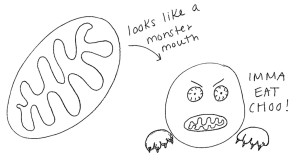I Love You, Mitochondria
I think that lately I’ve been taking my mitochondria for granted, so I decided to do a post about how sweet and helpful they are.
A mitochondrion (-on being singular, and -a being plural. So much lately about strange singular/plural pairings. I apologize…)

Yeesh, that wasn’t even a sentence. Take 2:
A mitochondrion (still with me?) is the organelle we have that provides our cells with energy. You know how you feel hyper and stupid when you eat too much sugar? Or is that just me?

The mitochondria are the ones that turn that sugar into the energy that makes you run around in circles.

They look like a bean on the outside.

But if you cut it open and look on the inside,

there are lots of folds and creases.


This shape allows the mitochondria to set up a chain of reactions that turn energy from sugar into energy the cell can use to do all the stuff they do–like move around or make proteins or help you read this blog. Whatever.
Mitochondria are especially cool because they aren’t really yours. They have their own DNA, they multiply on their own schedule, and they follow their own rules.

It is thought that they were once independent, stand-alone living things that squished inside another cell and took on their role as the energy producer. This explains why they look a lot like bacteria and have their own DNA. This whole idea is called the Endosymbiont Theory. (I just heard a voice in my head say “you’re an endosymbiont theory.” I think I need counseling.)

You get your mitochondria from your mother only: egg cells have mitochondria, but sperm do not. Remember, the egg cell is humongous compared to the sperm, so you get most of your cellular accessories from your mom. The sperm just contribute DNA. They can’t bring much else on their marathon journey because, after all, it’s a race, and winner takes all–no point weighing oneself down with unnecessaries. Mom’s egg cell has to do the heavy lifting when it comes to providing baby’s first cell with what it needs. So technically, you get more DNA from your mother if you count your mitochondrial DNA, which you should.

This fact makes maternity tests very easy, because the mitochondrial DNA of a mother and child are the same (save a few mutations, since those just happen). But maternity tests aren’t as common as paternity tests: usually a woman is pretty sure if a kid is hers… since… well, you know. However, they are very helpful if you are studying ancestries… or identifying bodies.
So to recap:
1. Mitochondrion in singular, mitochondria is plural (are plural?).
2. Mitochondria provide your cells with energy.
3. They are not yours. You can’t tell them what to do.
4. You get them from you mom.
I hope they don’t ever realized that they have become our prisoners and must work forever as our slaves, tirelessly storing energy for our cells. If they ever rise up and revolt against us, we’re screwed.




